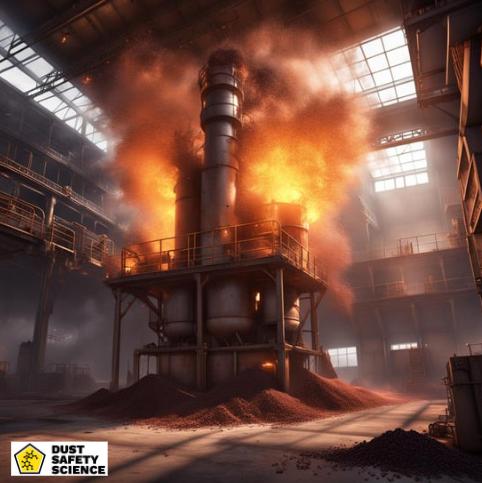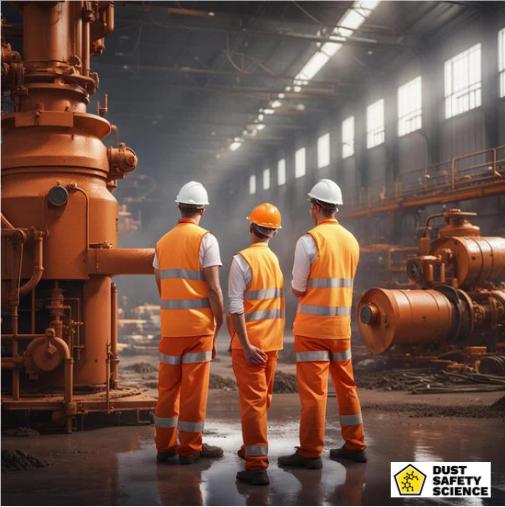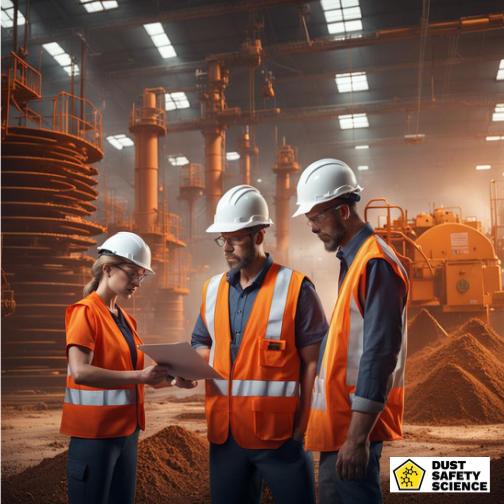Updated October 1, 2024 Authored by Dr. Chris Cloney and Jon Barrett

Key Takeaways:
- In a Dust Hazard Analysis, each piece of equipment and building compartment is evaluated for fire, flash fire and explosion hazards.
- Learn important terms and definitions related to Dust Hazard Analysis.
- There are 10 steps needed to complete an effective Dust Hazard Analysis process.
- From training to consulting, engineering support, compliance and software, there are many tools, companies and professionals that can support you on your teams combustible dust safety journey
Table of Contents:
- What is a Dust Hazard Analysis?
- Dust Hazard Analysis Definitions and Terms
- Steps to Complete a Dust Hazard Analysis
- Identifying Combustible Dusts, to Implement a Combustible Dust Hazard Analysis Strategy
- Steps in Preparing a Combustible Dust Hazard Analysis
- Best Practices for Conducting Comprehensive Combustible Dust Hazard Analysis (DHA)
- Offering Services for Dust Hazard Analysis
- Conclusion
What is a Dust Hazard Analysis?
A Dust Hazard Analysis, (DHA), is a systematic review to identify and evaluate the potential fire, flash fire, or explosion hazards associated with the presence of one or more combustible particulate solids in a process or facility (NFPA 652-19). A Dust Hazard Analysis is a critical step in evaluating the combustible dust hazards with a fire, a flash fire, and explosion hazards at your facility. Combustible dusts, stemming from various materials like wood, metal, chemicals, and more, can create a highly explosive environment. The role of DHA is paramount in identifying and assessing these combustible particulate solids and hazards. Not only does a combustible dust hazard assessment comply with regulations, but it also safeguards lives, property, and the environment from dust explosions. A Dust Hazard Analysis should be reviewed and updated every 5 years. (NFPA 652 – 7.1.4)
Read on to learn what a DHA is, why it is needed and the 10 steps to make sure it is effective when completed at your facility.
The goal of a DHA is to identify fire, flash-fire, and explosion hazards that pose a risk to people and property. Each process or area reviewed will fall into one of five categories:
- Not a Hazard: In instances where the Dust Hazard Analysis determines that there is no hazard present, no further investigation or precautionary measures may be necessary. This classification provides peace of mind, indicating that the process or area under scrutiny is safe from fire, flash-fire, or explosion risks associated with combustible dust.
- Could be Hazardous: Additional testing and information is required to determine whether a hazardous condition exists or not. If the analysis identifies the potential for hazards but lacks sufficient information or testing data to conclusively confirm their existence, additional investigations and data collection become imperative. This stage serves as a critical step towards ensuring safety by striving to either confirm or rule out hazardous conditions.
- Fire Hazard: Within the scope of a DHA, the recognition of a fire hazard signifies the potential for combustible materials to ignite and sustain a fire. This broader category encompasses various scenarios where the ignition of flammable substances poses a threat to safety and property such as overheating, smoldering and flaming fire.
- Flash Fire Hazard: Expanding further, a DHA may reveal the presence of flash fire hazards. Flash fires are rapid, intense fireballs that occur when flammable gasses, vapors, or dust particles ignite suddenly. Identifying flash fire hazards is crucial for implementing preventive measures and ensuring the safety of personnel and facilities.
- Explosion Hazard: Among the most severe outcomes, a DHA can uncover the risk of explosions. Explosions result from the rapid release of energy and can have devastating consequences. Identifying explosion hazards in a DHA is paramount to establishing comprehensive safety measures, including containing explosive dust, potential explosion characteristics of dust, and the protection of individuals and assets.
Dust Hazard Analysis Definitions and Terms
Below is a list of Dus Hazard Analysis-specific terms that are relevant to understanding and performing a DHA and a combustible dust hazard assessment, at your facility.
- Hazard: a physical or chemical characteristic that can potentially cause injury or damage.
- Scenario: description of an unexpected event or incident sequence that causes loss, as well as how well any safeguards performed.
- Consequence: The negative outcome of an event, typically measured in terms of injuries, fatalities, property loss, business loss, and any environmental impacts.
- Likelihood: The probability or frequency of an event
- Risk: The chances that an incident could injure people, destroy property, and cause environmental damage. Risk is often expressed as a combination of likelihood and consequence.
- Safeguard: Any protective device, system, or action that either interrupts further events after the inciting incident occurs or mitigates the consequences.

Steps to Complete a Dust Hazard Analysis
There are 10 steps recommended to implement a Dust Hazard Analysis.
- Step 1: Determine If Combustible Dust Is Present: This is completed using go/no-go screening, combustible dust testing for dust particles flammability, or explosion severity testing.
- Step 2: Identify Which Standards Apply: This includes NFPA standards, OSHA requirements, as well as local, state, regional and municipality requirements applicable to the facility. The NFPA 652 standard is just one of many standards ensuring safety.
- Step 3: Assemble the DHA Team: NFPA 652 recommends that a DHA be completed by a team, but requires that team to be led by a qualified person. Ideally the team should consist of experienced individuals from Plant Management, Environmental, Health and Safety specialists, plant engineering, Operations and Maintenance.
- Step 4: Collect the Required Documentation: Required documentation includes process flow diagrams, piping and instrumentation diagrams of the process, emergency response plans, housekeeping practices, explosion prevention, and more. A Dust Hazard Analysis Template can be created and updated with these essential items, and a combustible dust hazard assessment can be implemented.
- Step 5: Identify Credible Fire and Explosion Scenarios: Review each piece of equipment, processing area and building compartment for fire, flash fire and explosion hazards.
- Step 6: Review existing safeguards: Evaluate existing safeguards against the standard identified in Step 2.
- Step 7: Propose Additional Safeguards: Based on a gap analysis, identify areas where additional safeguards are needed.
- Step 8: Determine Proposed Change in Scenario Consequence and Likelihood: Complete a risk assessment to determine which risk reduction options should be used and in which order they should be applied.
- Step 9: Document Overall Recommendations: Write the DHA report to document overall methods used, findings and recommendations from the Dust Hazard Analysis. A Dust Hazard Analysis Template can be created and updated after each inspection.
- Step 10: Implement Recommendations: This is the final step in the process which requires that recommendations be implemented in a timely manner to reduce the risk of a dust fire, flash fire or explosion at the facility.

Identifying Combustible Dusts, to Implement a Combustible Dust Hazard Analysis Strategy:
Identifying combustible dusts within industrial facilities is a critical step towards ensuring workplace safety. To achieve this, facilities conduct thorough inspections, review existing safeguards, and perform a hazard assessment to understand the nature of the dust present. This process involves a comprehensive examination of the combustible dust’s composition, particle size, and combustibility. Through various sampling and testing methods, the properties and hazards associated with different types of combustible dust are determined. Analyzing these combustible particulate solids and characteristics aids in recognizing the specific risks posed by the dust, allowing for the implementation of targeted control measures and safety protocols to mitigate potential hazards. As a result, a dust hazard analysis assessment to identify hazards can be implemented.
Evaluating Dust Hazard Risks: Assessing the risks associated with various types of dust is crucial. This evaluation and test results consider factors like explosiveness, combustibility, and the conditions required for ignition. Understanding the hazards of different dust types helps in implementing appropriate safety measures and protocols. Some areas have more hazardous dust than other areas.
Analyzing Dust Generation and Accumulation Areas: Identifying areas where dust is generated and accumulates is essential. This involves examining production processes, equipment, high levels, and locations prone to dust accumulation. Understanding these areas helps in implementing targeted control measures to mitigate risks associated with dust accumulation and hazardous dust areas. This hazard assessment and identifying process will allow for a combustible dust hazard assessment to proceed, to prevent a dust cloud.
Reviewing Current Control Measures: Evaluating the effectiveness of existing dust control and mitigation measures is vital for ensuring a safe working environment. This review includes assessing the efficiency of ventilation systems, filtration, housekeeping practices, and other control measures in place to manage and reduce dust hazards.
Identifying Potential Ignition Sources: Spotting and documenting potential sources of ignition is critical in preventing dust explosions. This step involves identifying equipment, electrical sources, hot surfaces, sparks, or other heat-generating elements that could trigger a dust explosion, from a dust cloud. Documenting these sources helps in implementing preventive measures.
Determining the Likelihood of Dust Explosions: Assessing the probability and potential impact of dust explosions may involve a comprehensive risk analysis and hazard assessment. Considering factors such as dust characteristics, dust particle size, sources for dust clouds, identified hazards, control measures, and potential ignition sources helps in determining the likelihood of a dust explosion occurring and its potential consequences. This hazard assessment guides the development of safety protocols to minimize risks from a dust explosion.

Steps in Preparing a Combustible Dust Hazard Analysis:
Necessary Tools and Resources, as a Sample List:
- List of all process equipment and processing areas involved
- DHA Guidelines and Standards (e.g., NFPA 652 , OSHA requirements)
- Engineering drawings and documentation
- Dust testing equipment (if needed) or testing services, with test results, of different materials
- Personal protective equipment (PPE)
- Incident history records
- Dust Hazard Analysis Template
Gathering Relevant Data
- Facility Layout and Processes: Understanding the facility’s layout, equipment, materials used, and processes involved in combustible dust generation.
- Material Safety Data Sheets (MSDS): Detailed information about materials and their combustibility may be included on MSDS sheets.
- Dust Collection, Explosion Prevention, and Ventilation Systems: Assessing the efficiency and maintenance of these systems.
- Incident Reports: Reviewing past incidents related to combustible dust and combustible dust hazards. Combustible Dust Incidents occur in many industry sectors and involve many types of Manufacturing.
Team Assembly and Roles
- Team Leader: Oversees the entire DHA process, coordinates tasks, and ensures compliance. NFPA 652 requires this to be a Qualified Person.
- Process Experts: Individuals familiar with specific operations, any ignition source, and processes generating combustible dust.
- Safety Professionals: Experts in occupational safety and hazard analysis.
- Engineers: Provide technical expertise on equipment and system design.
- External Consultants: Specialized individuals who might be required for specific assessments.
Best Practices for Conducting Comprehensive Combustible Dust Hazard Analysis (DHA):
- Comprehensive Assessment: Begin by comprehensively evaluating all potential sources of combustible dust in your facility. Identify areas prone to dust accumulation, dust clouds, production processes, and equipment that might contribute to the hazard.
- Expert Involvement: Engage experienced professionals or consultants well-versed in dust hazards and safety protocols. Their insights can ensure a detailed analysis considering all aspects of combustible dust risk.
- Detailed Documentation: Maintain meticulous records throughout the DHA process. Document findings, risk assessments, and control measures implemented to address identified hazards. This documentation is crucial for ongoing compliance.
- Risk Prioritization: Prioritize risks based on severity and likelihood of occurrence. Focus on high-risk areas first and allocate resources accordingly for effective risk mitigation.
- Utilize Technology: Leverage advanced tools, such as dust monitoring equipment and simulation software, to aid in hazard analysis. These technological resources can enhance accuracy and efficiency in identifying hazards.
- Employee Training and Awareness: Conduct regular training sessions to educate employees about combustible dust risks, safety protocols, and emergency procedures. Awareness among staff is key to preventing incidents.
- Regular Reviews and Updates: Hazard analysis isn’t a one-time task. Establish a periodic review process to reassess risks, evaluate control measures, and adapt to any changes in processes or regulations.
- Regulatory Compliance: Stay updated with industry standards, codes, and regulations related to dust safety, including the Occupational Health and Safety Administration (OSHA), and NFPA standards. Ensure ongoing compliance with these guidelines to mitigate risks and avoid penalties.
- Continuous Improvement: Conduct a combustible dust hazard analysis as an ongoing process. Encourage feedback, conduct incident investigations, and use lessons learned to enhance safety measures continually.

Offering Services for Dust Hazard Analysis
When it comes to a Dust Hazard Analysis, (DHA), businesses can benefit from a range of specialized services and expertise. These services are provided by professionals and organizations dedicated to helping companies identify, assess, and mitigate dust hazards effectively. Selecting the right combination of these services depends on the unique needs, risk matrix, and circumstances of each business. Engaging with qualified professionals and organizations specializing in DHA is essential for achieving comprehensive and effective dust hazard management, ultimately ensuring workplace safety and regulatory compliance. Below are some essential services offered for DHA.
DHA Consultation: Experienced consultants can provide valuable guidance throughout the DHA process. They assist businesses in understanding the complexities of combustible dust hazards, regulatory requirements, and best practices. Consultants work closely with organizations to develop customized DHA plans and strategies tailored to their specific needs.
DHA Workshops and Training: DHA workshops and training programs are designed to educate employees and safety professionals on the fundamentals of dust hazard analysis. These programs cover hazard recognition, risk assessment techniques, and the implementation of control measures. Training ensures that personnel are well-equipped to actively participate in the DHA process.
DHA Audits and Assessments: DHA audits involve comprehensive evaluations of a facility’s dust hazard management practices and risk matrix. Experienced auditors assess existing processes, identify areas of improvement, process data, and recommend necessary changes. These audits help businesses enhance their safety measures and achieve compliance with regulatory requirements.
Engineering and Design Services: Engineering firms specializing in dust hazard management offer services related to the design and installation of dust collection systems, ignition source, explosion protection measures, and ventilation solutions. They ensure that facilities are equipped with the right engineering controls, products, and services, to mitigate combustible dust hazards effectively, and to prevent a dust cloud.
Combustible Dust Testing and Analysis: Laboratories and testing services can analyze dust samples and dust particles to determine their combustibility, minimum explosive concentration, and health-related properties. This combustible dust testing information aids in hazard assessment and helps businesses select appropriate control measures and preventive strategies.
Emergency Response Planning: Specialized consultants can assist in developing robust emergency response plans specific to dust-related incidents. These plans outline procedures for handling emergencies, protecting personnel, and minimizing damage in the event of a dust hazard incident.
Documentation and Compliance Support: Navigating the regulatory landscape can be complex. Service providers offer support in documenting DHA processes, maintaining records, and ensuring ongoing compliance with relevant regulations and standards, such as NFPA 652.
Risk Assessment Software: Advanced software solutions are available to streamline the risk assessment portion of DHA. These tools assist in hazard identification, consequence analysis, and the evaluation of risk mitigation strategies.

Conclusion
In this article covering Performing a Dust Hazard Analysis (DHA), we have delved into the critical aspects of identifying, assessing, and mitigating the often invisible threats posed by combustible dust and health-related dusts in industrial settings. Key points covered include the definition of DHA, the types of dust hazards, the DHA process, products and services available, and best practices.
The importance of DHA cannot be overstated. It is not merely a regulatory requirement but a proactive approach to safeguarding the well-being of employees, protecting valuable assets, and ensuring the longevity of business operations. Combustible dust hazards can have dire consequences if left unaddressed. A DHA is the crucial tool that empowers organizations to identify these hazards, assess their risks, and implement effective control measures. It is also extremely important that a team approach is used when completing the DHA and an experienced and qualified person is involved to lead the DHA team.
About Dust Safety Science
For more from Dr. Chris Cloney on Dust Hazard Analysis visit this podcast episode: Dust Hazard Analysis Requirements for Owners and Operators in NFPA 652

Resources:
Visit Dust Safety Science (Global Incident Tracking)
Visit Dust Safety Academy (Resources, Training and Events)
Visit Dust Safety Professionals (Need Help? Get Support Today!)
Visit Dust Safety Journal for the Dust Safety Science Monthly Journal
Subscribe to our Dust Safety Science Newsletter at Dust Safety Science Newsletter
Visit the Dust Safety Science blog for written articles on combustible dust safety including the latest research, expert opinions, and state-of-the art in fire and explosion protection.
